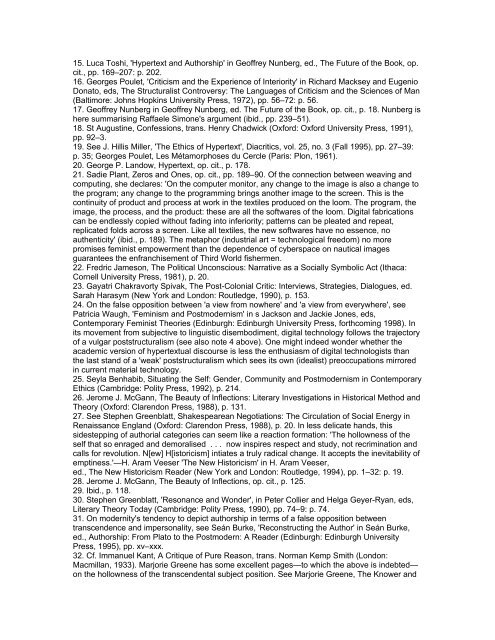You also want an ePaper? Increase the reach of your titles
YUMPU automatically turns print PDFs into web optimized ePapers that Google loves.
15. Luca Toshi, 'Hypertext <strong>and</strong> <strong>Author</strong>ship' <strong>in</strong> Ge<strong>of</strong>frey Nunberg, ed., <strong>The</strong> Future <strong>of</strong> <strong>the</strong> Book, op.<br />
cit., pp. 169–207: p. 202.<br />
16. Georges Poulet, '<strong>Criticism</strong> <strong>and</strong> <strong>the</strong> Experience <strong>of</strong> Interiority' <strong>in</strong> Richard Macksey <strong>and</strong> Eugenio<br />
Donato, eds, <strong>The</strong> Structuralist Controversy: <strong>The</strong> Languages <strong>of</strong> <strong>Criticism</strong> <strong>and</strong> <strong>the</strong> Sciences <strong>of</strong> Man<br />
(Baltimore: Johns Hopk<strong>in</strong>s University Press, 1972), pp. 56–72: p. 56.<br />
17. Ge<strong>of</strong>frey Nunberg <strong>in</strong> Ge<strong>of</strong>frey Nunberg, ed. <strong>The</strong> Future <strong>of</strong> <strong>the</strong> Book, op. cit., p. 18. Nunberg is<br />
here summaris<strong>in</strong>g Raffaele Simone's argument (ibid., pp. 239–51).<br />
18. St August<strong>in</strong>e, Confessions, trans. Henry Chadwick (Oxford: Oxford University Press, 1991),<br />
pp. 92–3.<br />
19. See J. Hillis Miller, '<strong>The</strong> Ethics <strong>of</strong> Hypertext', Diacritics, vol. 25, no. 3 (Fall 1995), pp. 27–39:<br />
p. 35; Georges Poulet, Les Métamorphoses du Cercle (Paris: Plon, 1961).<br />
20. George P. L<strong>and</strong>ow, Hypertext, op. cit., p. 178.<br />
21. Sadie Plant, Zeros <strong>and</strong> Ones, op. cit., pp. 189–90. Of <strong>the</strong> connection between weav<strong>in</strong>g <strong>and</strong><br />
comput<strong>in</strong>g, she declares: 'On <strong>the</strong> computer monitor, any change to <strong>the</strong> image is also a change to<br />
<strong>the</strong> program; any change to <strong>the</strong> programm<strong>in</strong>g br<strong>in</strong>gs ano<strong>the</strong>r image to <strong>the</strong> screen. This is <strong>the</strong><br />
cont<strong>in</strong>uity <strong>of</strong> product <strong>and</strong> process at work <strong>in</strong> <strong>the</strong> textiles produced on <strong>the</strong> loom. <strong>The</strong> program, <strong>the</strong><br />
image, <strong>the</strong> process, <strong>and</strong> <strong>the</strong> product: <strong>the</strong>se are all <strong>the</strong> s<strong>of</strong>twares <strong>of</strong> <strong>the</strong> loom. Digital fabrications<br />
can be endlessly copied without fad<strong>in</strong>g <strong>in</strong>to <strong>in</strong>feriority; patterns can be pleated <strong>and</strong> repeat,<br />
replicated folds across a screen. Like all textiles, <strong>the</strong> new s<strong>of</strong>twares have no essence, no<br />
au<strong>the</strong>nticity' (ibid., p. 189). <strong>The</strong> metaphor (<strong>in</strong>dustrial art = technological freedom) no more<br />
promises fem<strong>in</strong>ist empowerment than <strong>the</strong> dependence <strong>of</strong> cyberspace on nautical images<br />
guarantees <strong>the</strong> enfranchisement <strong>of</strong> Third World fishermen.<br />
22. Fredric Jameson, <strong>The</strong> Political Unconscious: Narrative as a Socially Symbolic Act (Ithaca:<br />
Cornell University Press, 1981), p. 20.<br />
23. Gayatri Chakravorty Spivak, <strong>The</strong> Post-Colonial Critic: Interviews, Strategies, Dialogues, ed.<br />
Sarah Harasym (New York <strong>and</strong> London: Routledge, 1990), p. 153.<br />
24. On <strong>the</strong> false opposition between 'a view from nowhere' <strong>and</strong> 'a view from everywhere', see<br />
Patricia Waugh, 'Fem<strong>in</strong>ism <strong>and</strong> Postmodernism' <strong>in</strong> s Jackson <strong>and</strong> Jackie Jones, eds,<br />
Contemporary Fem<strong>in</strong>ist <strong>The</strong>ories (Ed<strong>in</strong>burgh: Ed<strong>in</strong>burgh University Press, forthcom<strong>in</strong>g 1998). In<br />
its movement from subjective to l<strong>in</strong>guistic disembodiment, digital technology follows <strong>the</strong> trajectory<br />
<strong>of</strong> a vulgar poststructuralism (see also note 4 above). One might <strong>in</strong>deed wonder whe<strong>the</strong>r <strong>the</strong><br />
academic version <strong>of</strong> hypertextual discourse is less <strong>the</strong> enthusiasm <strong>of</strong> digital technologists than<br />
<strong>the</strong> last st<strong>and</strong> <strong>of</strong> a 'weak' poststructuralism which sees its own (idealist) preoccupations mirrored<br />
<strong>in</strong> current material technology.<br />
25. Seyla Benhabib, Situat<strong>in</strong>g <strong>the</strong> Self: Gender, Community <strong>and</strong> Postmodernism <strong>in</strong> Contemporary<br />
Ethics (Cambridge: Polity Press, 1992), p. 214.<br />
26. Jerome J. McGann, <strong>The</strong> Beauty <strong>of</strong> Inflections: Literary Investigations <strong>in</strong> Historical Method <strong>and</strong><br />
<strong>The</strong>ory (Oxford: Clarendon Press, 1988), p. 131.<br />
27. See Stephen Greenblatt, Shakespearean Negotiations: <strong>The</strong> Circulation <strong>of</strong> Social Energy <strong>in</strong><br />
Renaissance Engl<strong>and</strong> (Oxford: Clarendon Press, 1988), p. 20. In less delicate h<strong>and</strong>s, this<br />
sidestepp<strong>in</strong>g <strong>of</strong> authorial categories can seem like a reaction formation: '<strong>The</strong> hollowness <strong>of</strong> <strong>the</strong><br />
self that so enraged <strong>and</strong> demoralised . . . now <strong>in</strong>spires respect <strong>and</strong> study, not recrim<strong>in</strong>ation <strong>and</strong><br />
calls for revolution. N[ew] H[istoricism] <strong>in</strong>tiates a truly radical change. It accepts <strong>the</strong> <strong>in</strong>evitability <strong>of</strong><br />
empt<strong>in</strong>ess.'—H. Aram Veeser '<strong>The</strong> New Historicism' <strong>in</strong> H. Aram Veeser,<br />
ed., <strong>The</strong> New Historicism Reader (New York <strong>and</strong> London: Routledge, 1994), pp. 1–32: p. 19.<br />
28. Jerome J. McGann, <strong>The</strong> Beauty <strong>of</strong> Inflections, op. cit., p. 125.<br />
29. Ibid., p. 118.<br />
30. Stephen Greenblatt, 'Resonance <strong>and</strong> Wonder', <strong>in</strong> Peter Collier <strong>and</strong> Helga Geyer-Ryan, eds,<br />
Literary <strong>The</strong>ory Today (Cambridge: Polity Press, 1990), pp. 74–9: p. 74.<br />
31. On modernity's tendency to depict authorship <strong>in</strong> terms <strong>of</strong> a false opposition between<br />
transcendence <strong>and</strong> impersonality, see Seán <strong>Burke</strong>, 'Reconstruct<strong>in</strong>g <strong>the</strong> <strong>Author</strong>' <strong>in</strong> Seán <strong>Burke</strong>,<br />
ed., <strong>Author</strong>ship: From Plato to <strong>the</strong> Postmodern: A Reader (Ed<strong>in</strong>burgh: Ed<strong>in</strong>burgh University<br />
Press, 1995), pp. xv–xxx.<br />
32. Cf. Immanuel Kant, A Critique <strong>of</strong> Pure Reason, trans. Norman Kemp Smith (London:<br />
Macmillan, 1933). Marjorie Greene has some excellent pages—to which <strong>the</strong> above is <strong>in</strong>debted—<br />
on <strong>the</strong> hollowness <strong>of</strong> <strong>the</strong> transcendental subject position. See Marjorie Greene, <strong>The</strong> Knower <strong>and</strong>


















